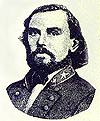| Major General Thomas C. Hindman |
 |
| Hindman was born in Knoxville, Knox County, Tennessee on January 28, 1828. His family descended from English and Scottish notables. He moved with his parents to Jacksonville, Calhoun County, Alabama in 1832 and then to Ripley, Tippah County, Mississippi in 1841. He attended public and private schools; graduating with honors from Lawrenceville Classical Institute near Princeton, New Jersey. Hindman spent time in New York after graduation. He returned to Mississippi to study law, but the study was interrupted by the Mexican War. At the outbreak of the war, Hindman joined the the Second Mississippi Regiment under Colonel Clark. He served throughout the war as Lieutenant and later as Captain of his company. The unit served as occupation troops and had no active campaigns. After the war, he returned to Ripley, Mississippi to study law and was admitted to the bar in 1851. He was actively involved in state politics. He was a delegate to the Democratic Convention and the Southern States Rights Convention; supporting Jefferson Davis' losing campaign for Governor. He served in the Mississippi State House of Representatives from 1854-1856. Hindman moved to Helena, Arkansas in 1853; setting up his law practice. During this period, Hindman fought several duels; achieving a reputation as a hot head. He came to the attention of the ruling political family of the day because of his oratory skills. He was elected as a Democrat to the Thirty-sixth Congress (March 4, 1859-March 3, 1861). A rift developed between the ruling dynasty and the Congressman over the dynasty allowing Know-Nothings and old Whigs into the party. The political war was a bitter one. Hindman was the victor; defeating the family in the 1860 elections. |
 |
| Maj. Gen. Thomas Hindman |
| He declined to take his seat after his second election and turned his attention to the cause of Southern Rights and favored secession. He was present when the convention voted to secede from the Union. Hindman raised 10 companies at his own expense and was assigned to the Army of Tennessee. He was commissioned Brigadier General September 28, 1861, and Major General April 18, 1862. He lead his brigade at the Battle of Shiloh and was wounded. He rejoined the army at Corinth, after recovering from his wounds. Following the removal of Major General Earl Van Dorn, Hindman took command of the Trans-Mississippi. When he arrived in Little Rock he found few troops or supplies. Through a series of deceptions, he convinced the Federals that the city was well defended. He proceeded to declare martial law, imposed price controls and enforced acceptance of Confederate notes. He ordered the destruction of all property that might fall into enemy hands. Hindman was criticized for his severity in enforcing conscription and maintaining discipline. |
| He also instituted guerilla warfare tactics. Confederate States President, Jefferson Davis, did not approve of guerilla warfare, considering it too disorganized. However, on April 21, 1862 Davis approved an act to authorize commissioned officers to form bands of Partisan rangers. General Hindman published his "Confederate Partisan Act in Missouri". Hindman believed fully in the military value of guerilla warfare. He establised a new procedure. When 10 men came together they were to elect a captain, one sergeant and one corporal. They were then to commence operations against the enemy without waiting to receive special instructions. Hindman's ruthless methods led his opponents to protest to Richmond. Hindman was ousted, replaced by Theopilus Holmes. Hindman was ordered to northwest Arkansas. After his defeat at Prairie Grove, he was transferred to the Army of Tennessee under Braxton Bragg. Hindman commanded a division at Chickamauga and was severely wounded in the Atlanta campaign. The wound was so severe as to incapacitate him from further field duty. During the several months he spent recovering, his daughter Sallie died. The Confederacy began to collapse. Hindman and his family set out for Texas where he heard of the surrender. He and his family crossed the border into Mexico; staying only until June 1866. He returned to Arkansas and dove back into politics. Hindman was assassinated while sitting in his livingroom in Helena Arkansas on September 27, 1868. He was shot in the neck and jaw by a musket fired through his window. He realized he was mortally wounded and made his way to the front porch. He encouraged his supporters, arranged for the care of his family, then died. The crime was never solved. His body was interred at Maple Hill Cemetery in Helena, Arkansas. |
| Hindman Hall at Prairie Grove Battlefield |